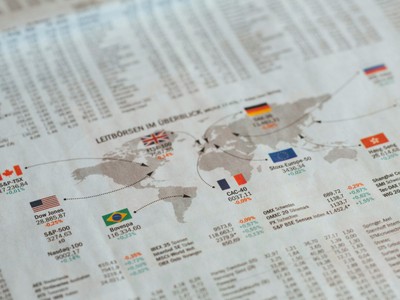Usually the business cycle follows: slowdown, recession, recovery and expansion. However, this time we have skipped the recovery and gone straight to the expansionary phase. This follows higher commodity prices, as the world equity markets are led by the Chinese and US expanding economies. When looking at manufacturing and production data for the US, it seems there is a strong bullish sentiment in the US economy. Moreover, in China recent GDP growth and export/import data suggests that neither economy is likely to have a slowdown in the next 12 months.
However, the real question that we should be concerned about, from an asset allocation point of view, is how long can this expansionary phase go on for? My view is that because of the extensive QE programs of major Central Banks, this cycle is different. This is marked by the profits recession since 2009, whilst equities have had strong, sustained gains. In 2017 fiscal reflation has replaced austerity policies, and will hopefully spur global economic growth on to its next leg.
This fiscal reflation starts with President Trump, who hopes to implement a $1trillion fiscal stimulus package to ‘make America great again’. This package includes widespread corporate tax cuts and infrastructure spending, which the markets have leapt on. But the other side to Trump; immigration bans, protectionism and international hostility is something that has not been priced in. The problem Trump has, is not only is th e US labour market at near saturation point, but high-skilled jobs are taking over the market. Manufacturing jobs ‘taken’ from the Chinese are unsustainable in the long-run by just merely raising tariff barriers. The labour market and economy is changing to being more dynamic and far more technology facing – something that Trump needs to take into account when delivering his fiscal stimulus package.
The make-up of so-called tradition sectors, such as retail, has changed beyond recognition. In 2006 banks and oil companies dominated the largest 10 companies in the US. Now, five out of the top ten are technology companies, and this is set to rise further. A great example of this shift to tech is Amazon. In 2006 it had a market capitalisation of only $17billion. Today it stands at $850billion and rising. Much of this future growth will be driven by Amazon’s web services, which is predicted to outstrip the rest of the retail sector by 2023. These changes to conventional high-street companies to an online platform are going to fundamentally change the nature of consumer patterns and the labour market as a whole.
Moreover, two other changes to the global economy that will drive future economic growth are the developments to robotics and Artificial Intelligence (AI). Arguably, we are now entering the ‘Second Machine Age’, from the expected boosts to GDP from these two factors. Research by Nomura and Oxford University predict that in 20 years’ time half of all jobs in Japan can be taken over by AI/robotics. Conventional industries such as accountancy and law are all a threat to being replaced by future AI technology and we are already seeing improvements in AI affecting long-standing industries, with financial services at the forefront. However, what this technology does offer is a rise in productivity and thus GDP for all. Ensuring that workers who are made redundant to these advancements are looked after could be the next social pressure for developed economies.
In addition to the drivers of future growth, where that growth lands is also going to cause a seismic shift in one’s investment decision making. A recent report by PwC predicts that today’s ‘Emerging Economies’ will make up 50% of world GDP by 2050. The report is favourable to the UK too, who should be nimble enough to remain in the top 10 economies by 2050, unlike many of our European partners. The UK is also projected to be the fastest growth economy of the G7, on average, over the whole period. According to the report, Vietnam, India and Bangladesh have the potential to be the fastest economies, with growth of 5% pa. This drastic shift will force our asset allocation to move into these expanding economies, to ensure sustained long-term returns.
My three main investment themes for now incorporate these changes in technology and a shift towards emerging markets. This includes: e-commerce, energy and Artificial Intelligence. E-commerce only makes up 10% of US and UK sales, but this is set to improve as mobile devices develop and the networks advance in the future. Traditional high-street shops need to evolve or die. The changes in energy is in conjunction with changes to the auto industry too. Efficiencies in solar and clean tech will make it impossible for traditional oil and gas companies to sustain their current business model. The managers of Scottish Mortgage Investment Trust believe the major oil companies have between 5-10 years left in their lifetime. The CEO of Tesla believes by 2030 all cars will be electric – clearly highlighting the trend away from traditional energy sources. Artificial Intelligence clearly has the potential to revolutionise society and the economy. In combination with technology such as 3D printing, it is easy to see how the fabric of consumer-company interactions could drastically change in the future.
In turn, although there are a number of threats to face in the short term, sustained longer term investment opportunities are evident too. A shift towards a greater exposure to new technology and non-conventional geographical locations will, I believe, dominate investment strategy in the coming future.




